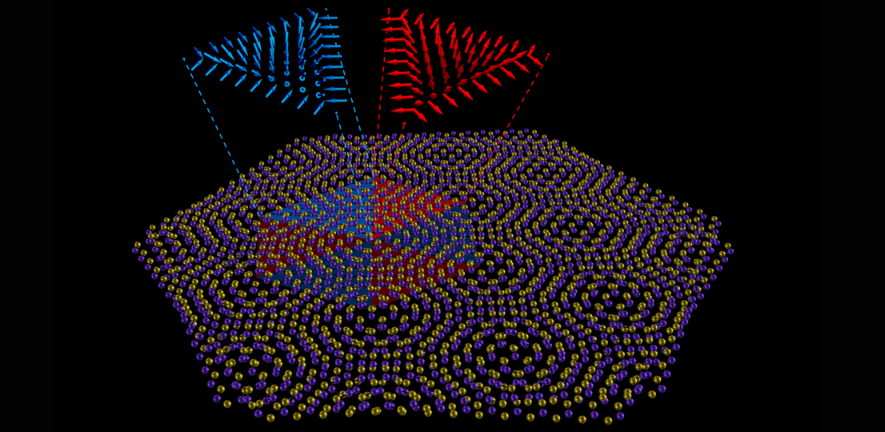A new topological phase in a two-dimensional system has been discovered by scientists at Cambridge University. This can be used as a new platform for examining topological physics in nanoscale devices.

Illustration of merons in a twisted bilayer. Image Credit: Daniel Bennett
Two-dimensional materials like graphene have acted as a playground for the experimental breakthrough and theoretical knowledge of an extensive range of phenomena in materials science and physics.
An extensive range of functionality could be obtained in devices by making use of various 2D materials or accumulating combinations of various layers.
Recently, it was found that in materials like hexagonal boron nitride (hBN), which are less symmetric compared to graphene, ferroelectricity takes place when one-layer slides over the other and further splits a symmetry.
Ferroelectricity is the shifting of an electric dipole moment of the material with an electric field, which is a beneficial property for memory storage and information processing.
They develop an attractive interference pattern called a moiré superlattice when 2D materials are distorted around one another. This could radically alter the physical properties.
The different stacking regions turn out to be polarized when hBN and identical materials are twisted. This is a result of a normal network of polar domains, which have also been shown to result in ferroelectricity.
In this new study, scientists from Cambridge’s Cavendish Laboratory and the University of Liège, Belgium, have found that there is more to such polar domains: they are naturally topological and form objects called antimerons and merons.
The study has been published in the journal Nature Communications.
The polarization in twisted systems points in the out-of-plane direction, that is to say perpendicular to the layers.
Dr Daniel Bennett, Study First Author, Theory of Condensed Matter Group, Cavendish Laboratory, University of Cambridge
“What we found is that the symmetry breaking caused by sliding or twisting also results in an in-plane polarisation which is similar in strength to the out-of-plane polarisation. The in-plane polarization forms a beautiful vector field, and its shape is determined entirely by the symmetry of the layers.”
Bennett began this project at the Cavendish Laboratory and is currently based at Harvard University, USA.
The breakthrough of the in-plane polarization reveals the fact that the electrical properties of 2D twisted systems are highly complicated compared to what was thought earlier. Most significantly, by integrating both the in-plane and out-of-plane parts of the polarization, the group realized that the polarization in such twisted bilayers is known to be topologically non-trivial.
“In each domain, the polarization field winds around by half a revolution, forming a topological object known as a meron (half a skyrmion). Throughout the twisted layer, a robust network of merons and antimerons forms,” said Dr Robert-Jan Slager, whose group at the Cavendish Laboratory was involved in the study.
In physics, most things can be understood in terms of energy. Nature is lazy and likes to do things in the most efficient way possible, doing so by minimizing the energy of a system.
Dr. Daniel Bennett, Study First Author, Theory of Condensed Matter Group, Cavendish Laboratory, University of Cambridge
Normally, the phase that a material will adopt has the lowest energy. But topological properties and topological phases are not identified by energies but by the several symmetries of a system.
The system’s physical properties, like its magnetic or electric fields, could develop complicated structures that wind or tie themselves in knots as they are compelled to by symmetry.
The energetic cost of untying these knots is very high, so these structures end up being quite robust. Being able to create, destroy and control these topological objects is very appealing, for example in the field of topological quantum computing.
Robert-Jan SlagerView, Theory of Condensed Matter Group, Cavendish Laboratory, University of Cambridge
For this to be done, the future aim of the scientists is to develop a better knowledge of topological polarization and also to develop a proof of concept for a device in which the polar merons or antimerons they found can be regulated or result in an exciting new physical phenomenon.
Bennett started this project during his Ph.D. at Cambridge’s Cavendish Laboratory before he moved to the University of Liège, Belgium, where he continued this research with Professor Philippe Ghosez and Dr. Eric Bousquet, where both are experts in the field of ferroelectricity.
Journal Reference
Bennett, D., et al. (2023) Polar meron-antimeron networks in strained and twisted bilayers. Nature Communications. https://doi.org/10.1038/s41467-023-37337-8.